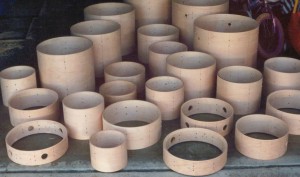Drum City Guitarland Product Review: Selecting Your Drums- The Heart and Soul!
by Kyle Christy
There are many things that you can do to a drum. From sizes, color finish, wrap or lacquer, lug choices, rims, but the start of it all is the “Wood/Shell”. The shell is the main part of any drum and is really where the sound starts once the head has been struck. Whether you have a wood shell that’s been glued in plies or a metal shell cast in a mold, everything that goes into making a shell has an effect on the sound the drum produces. So let’s take a look at the many different materials used to a make a shell and the tones that are associated with each. Here I have for you the most common woods, metals, and synthetics used to manufacture drum shells.
WOOD TYPES
Maple: Even amount of highs and mids, slightly warm lows. This I your most common wood choice and All Purpose shell.
Birch: Boosted high frequencies, slightly reduced midrange, good low-end punch. Loud and Cutting.
Mahogany: Muted highs, smooth midrange, warm/rich low-end. Vibrant and Resonant.
Walnut: Equal amount of highs, mids, and lows. Big and Warm.
Oak: Soft highs, good amount of midrange, slightly warm lows. All purpose with fairly quick decay.
Beech: Pronounced highs and mids, good low-end punch. Sensitive and Focused.
Cherry: Boosted highs, punchy midrange, average low-end. Bright and Sensitive.
Bubinga: Even amount of highs and mids, rich low end. Sensitive and punchy.
Poplar: Soft highs and mids, boosted low-end warmth. Smooth and even.
Ash: Pronounced, warm highs and mids, average low end. Throaty and warm.
Lets step into the “EXOTIC” woods. Exotic woods have been being produced for years now. From purpleheart which produces extreme sensitivity, lots of punchy low/mid with excellent presence and cut. To your submerged hardwoods flamed red and yellow birch, bird’s eye maple, quilted maple, blistered maple, and Honduran mahogany. With more than 3,300 species of timber out there in the wild, the potential for new sound is nearly limitless. Each type of wood has its own unique sound when molded into a cylinder. So when choosing a shell type stop and consider what type of style you will be playing and which sound is going to best match your needs. As with woods, a seemingly limitless number of metal alloys are available to drum manufacturers. So I stress to you again consider the music and playing style you are going for. Use the basic sonic properties of the more common metals to find the best match.
METALS
Steel (carbon): Clear highs, average midrange and low-end. All-purpose.
Brass: Open highs, mids, and lows. Musically warm and vibrant.
Aluminum: Crisp highs, warm/open midrange and low end. Colorful and sensitive.
Copper: Muted highs, pronounced midrange and low-end. Loud and powerful.
Bronze: Muted highs, powerful midrange and low-end. Warm and responsive.
Titanium: Clear highs and mids, boxy low end. Clear and focused.
Synthetics have been used for drums for thirty to fort years, but not as explored to woods and metals. Synthetic materials offer a more clean and focused tone being a very surprisingly versatile choice. Don’t overlook this option.!
SYNTHETICS
Carbon fiber: Even amount of highs and mids, slightly warm low-end. Controlled and dry.
Acrylic: Warm highs, mids, and low-end. Powerful attack and presence. “THANK YOU JOHN BONHAM”!
Fiberglass: Even amount of highs, mids, and lows. Controlled and focused.
Lastly the shell construction is done in many different ways.
WOOD
Plywood: Long sustain with plenty of volume and varying fundamental pitch.
Stave: Short sustain and higher fundamental pitch.
Steam-bent: Vibrant with long sustain and true fundamental pitch.
Solid: Long sustain and higher fundamental pitch.
Segment: Short sustain and higher and more focused fundamental pitch.
METAL
Cast: long sustain and higher fundamental pitch.
Spun: Vibrant with long sustain and true fundamental pitch.
So when picking out a new kit or even used be sure to think of “The Heart and Soul”!
Category: Shop Talk






